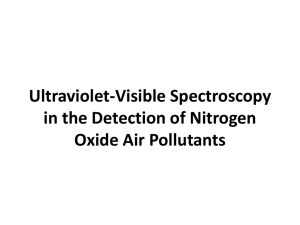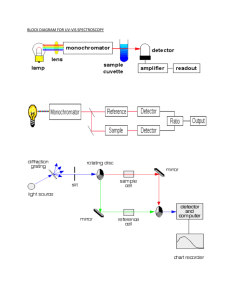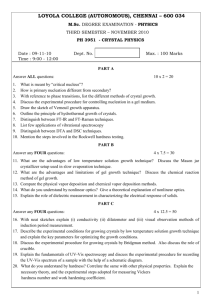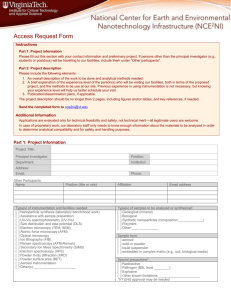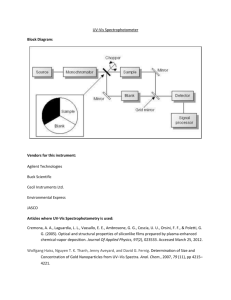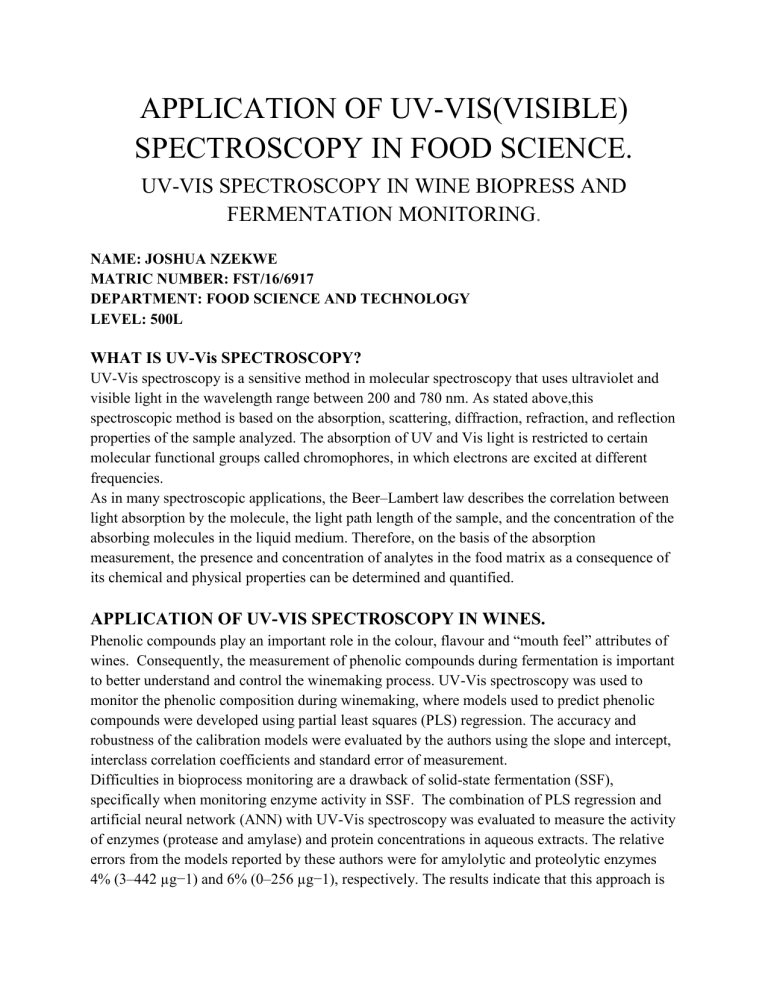
APPLICATION OF UV-VIS(VISIBLE) SPECTROSCOPY IN FOOD SCIENCE. UV-VIS SPECTROSCOPY IN WINE BIOPRESS AND FERMENTATION MONITORING. NAME: JOSHUA NZEKWE MATRIC NUMBER: FST/16/6917 DEPARTMENT: FOOD SCIENCE AND TECHNOLOGY LEVEL: 500L WHAT IS UV-Vis SPECTROSCOPY? UV-Vis spectroscopy is a sensitive method in molecular spectroscopy that uses ultraviolet and visible light in the wavelength range between 200 and 780 nm. As stated above,this spectroscopic method is based on the absorption, scattering, diffraction, refraction, and reflection properties of the sample analyzed. The absorption of UV and Vis light is restricted to certain molecular functional groups called chromophores, in which electrons are excited at different frequencies. As in many spectroscopic applications, the Beer–Lambert law describes the correlation between light absorption by the molecule, the light path length of the sample, and the concentration of the absorbing molecules in the liquid medium. Therefore, on the basis of the absorption measurement, the presence and concentration of analytes in the food matrix as a consequence of its chemical and physical properties can be determined and quantified. APPLICATION OF UV-VIS SPECTROSCOPY IN WINES. Phenolic compounds play an important role in the colour, flavour and “mouth feel” attributes of wines. Consequently, the measurement of phenolic compounds during fermentation is important to better understand and control the winemaking process. UV-Vis spectroscopy was used to monitor the phenolic composition during winemaking, where models used to predict phenolic compounds were developed using partial least squares (PLS) regression. The accuracy and robustness of the calibration models were evaluated by the authors using the slope and intercept, interclass correlation coefficients and standard error of measurement. Difficulties in bioprocess monitoring are a drawback of solid-state fermentation (SSF), specifically when monitoring enzyme activity in SSF. The combination of PLS regression and artificial neural network (ANN) with UV-Vis spectroscopy was evaluated to measure the activity of enzymes (protease and amylase) and protein concentrations in aqueous extracts. The relative errors from the models reported by these authors were for amylolytic and proteolytic enzymes 4% (3–442 µg−1) and 6% (0–256 µg−1), respectively. The results indicate that this approach is suitable for developing a chemosensor for monitoring SSFs, reducing the analytical work for quantification of enzyme activities. Supernatants from a fermentation process of Pichia pastoris were analysed by a combination of spectroscopic techniques. Models were developed to predict the concentration of glycerol and methanol in the supernatants using PLS regression. Overall, the results reported indicated that UV-Vis spectroscopy was able to quantify protein contents in the supernatants analysed. The application of UV-Vis spectroscopy was evaluated as an inline sensor to monitor changes in colour and total phenol concentration during red wine fermentation. The sensor presented by the authors was based on multiple light-emitting diodes (LEDs) (280–525 nm). According to the authors, these studies confirmed that LED sensors can be used to measure the concentration of phenolic compounds in-line. The incorporation of a 100 µm path length flow cell avoids the need for dilution of the sample, making in-line measurements possible. The sensor provides in-line measurement of the evolution of the total phenolic content and colour extraction patterns during red wine fermentation. The crystallization of biopharmaceuticals can be problematic due to the impurities present during the biosynthesis of these compounds. During the bioprocess, impurities can lead to changes in the properties of the drug that can significantly reduce its effectiveness or even put the final user in danger. In this study, the authors evaluated the effects of solvent, cooling rate, seeding and purity of the initial material on the final size distribution and purity of the crystals, where the whole process was monitored using UV-Vis spectroscopy. Monitoring the utilisation of sugars during fermentation is a key aspect to optimise product development and maintain a healthy environment for microorganisms to grow and thrive. However, an industry standard technique for the rapid, inexpensive and sensitive detection of sugars in complex media (containing a number of components: nutrients, cell debris, waste as well as the target products) has yet to be established. A number of authors have evaluated the use of UV-Vis spectrophotometry for the quantitative determination of xylose during fermentation. Absorbance at the wavelength 671 nm shows a linear relationship with xylose concentration within a range of 0.1–0.5 g/L. The authors concluded that UV-Vis spectroscopy was able to measure xylose concentration during fermentation. REFERENCES: 1. Kara, S.; Mueller, J.J.; Liese, A. Online analysis methods for monitoring of bioprocesses. Chim. Oggi 2011. 2. Lourenço, N.D.; Lopes, J.A.; Almeida, C.F.; Sarraguça, M.C.; Pinheiro, H.M. Bioreactor monitoring with spectroscopy and chemometrics: A review. Anal. Bioanal. Chem. 2012, 404, 1211–1237. [CrossRef] [PubMed]

